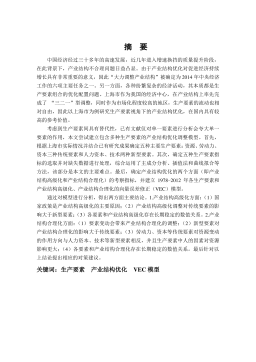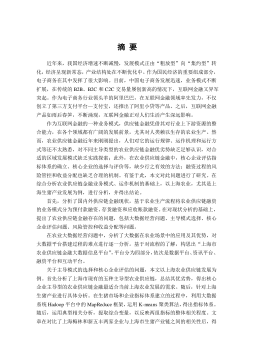金融控股集团的风险控制研究
摘要随着各国金融市场的不断渗透与融合,金融已经走进了全球化、一体化的时代。全球金融交易额在不断的扩大,金融衍生品也在不断的推陈出新,据吕震(1999)估算,衍生交易额已从1987年的8600亿美元到20世纪90年代末的约37万亿美元,而金融工具的迅猛发展势必使金融体制面临着新的挑战。为了应对不断变化的金融环境,世界各国都在不断地调整自己的经营策略,竭力创建与之相适应的金融体制。美国、日本、英国等国都纷纷走上了混业经营的道路,一方面,混业经营拥有分业经营所不具备的优势,例如,规模经济、范围经济、分散风险、协同效应等;另一方面,也是全球经济、政治的变革所致。作为新兴大国——中国而言,放开过多的分业...
相关推荐
-
我国基层财政困难的制度成因分析与对策研究VIP免费

 2024-09-20 33
2024-09-20 33 -
我国煤电产业链纵向交易合约机制研究VIP免费

 2024-09-20 28
2024-09-20 28 -
生产要素视角下的上海市产业结构优化研究VIP免费

 2025-01-09 7
2025-01-09 7 -
我国银行业结构与经济结构关系研究VIP免费

 2025-01-09 7
2025-01-09 7 -
大数据视角下农业供应链金融研究VIP免费

 2025-01-09 6
2025-01-09 6 -
跨国大型综合超市的规划研究VIP免费

 2025-01-09 6
2025-01-09 6 -
跨境电商农产品质量安全问题研究VIP免费

 2025-01-09 7
2025-01-09 7 -
世界市场的虚拟化与我国国际电子商务发展方向研究VIP免费

 2025-01-09 9
2025-01-09 9 -
中国政府对电力行业的价格规制问题研究VIP免费

 2025-01-09 14
2025-01-09 14 -
中小企业信息化系统集成技术研究VIP免费

 2025-01-09 14
2025-01-09 14
相关内容
-

跨国大型综合超市的规划研究
分类:高等教育资料
时间:2025-01-09
标签:无
格式:PDF
价格:15 积分
-

跨境电商农产品质量安全问题研究
分类:高等教育资料
时间:2025-01-09
标签:无
格式:PDF
价格:15 积分
-

世界市场的虚拟化与我国国际电子商务发展方向研究
分类:高等教育资料
时间:2025-01-09
标签:无
格式:PDF
价格:15 积分
-

中国政府对电力行业的价格规制问题研究
分类:高等教育资料
时间:2025-01-09
标签:无
格式:PDF
价格:15 积分
-

中小企业信息化系统集成技术研究
分类:高等教育资料
时间:2025-01-09
标签:无
格式:PDF
价格:15 积分





